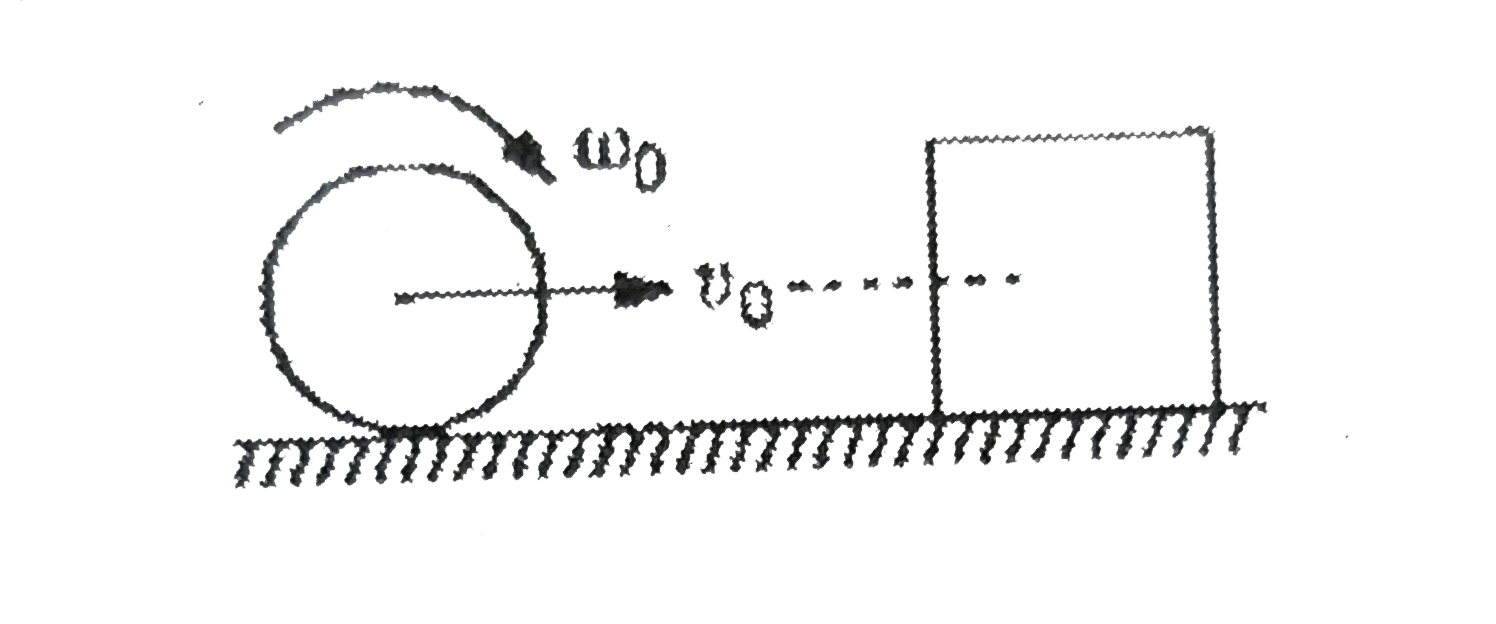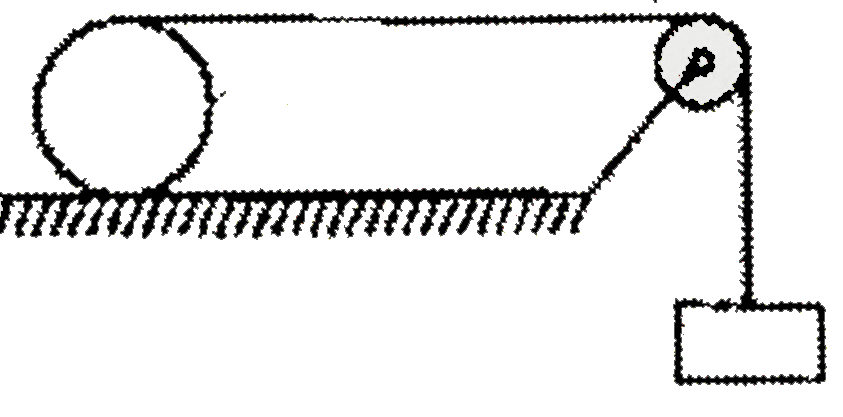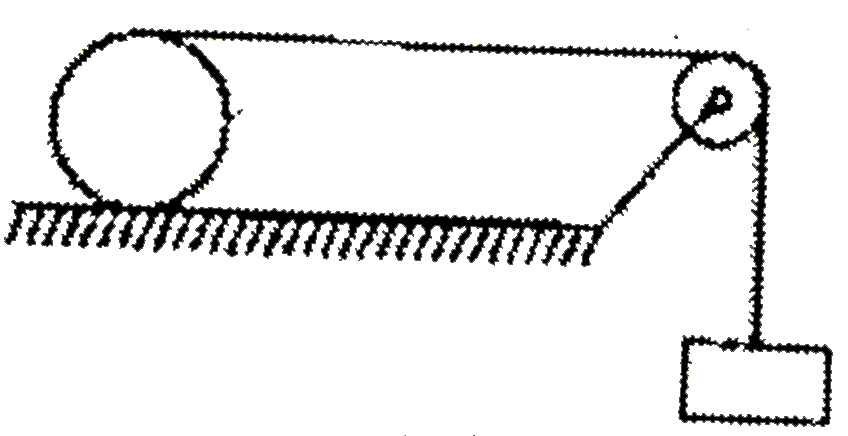COMPREHENSION_TYPE from SHREE BALAJI PHYSICS Chapter 4 RIGID BODY MOTION for Class 11
| Class 11 | PHYSICS |
| Chapter | RIGID BODY MOTION |
| SHREE BALAJI PHYSICS | COMPREHENSION_TYPE |
| Medium | English |
| Academic Year | 2023-2024 |
Question 1
A solid cylinder of mass m rolls on a rough surface with velocity v0. It collides elastically with a cubical block of same mass at rest. The centre of mass of both the bodies are at same height. Coefficient of friction between horizontal surface and cylinder as well as horizontal surface and cube is μ. No frictional exists between cylinder and cube. The cylinder collides the, cube at t=0, then.

Percentage of energy of cylinder lost due to collision is: View SolutionQuestion 2
A solid cylinder of mass m rolls on a rough surface with velocity v0. It collides elastically with a cubical block of same mass at rest. The centre of mass of both the bodies are at same height. Coefficient of friction between horizontal surface and cylinder as well as horizontal surface and cube is μ. No frictional exists between cylinder and cube. The cylinder collides the, cube at t=0, then.

Regarding frictional force acting on cylinder we can say that:View SolutionQuestion 3
A solid cylinder of mass m rolls on a rough surface with velocity v0. It collides elastically with a cubical block of same mass at rest. The centre of mass of both the bodies are at same height. Coefficient of friction between horizontal surface and cylinder as well as horizontal surface and cube is μ. No frictional exists between cylinder and cube. The cylinder collides the, cube at t=0, then.

Time after which the cylinder starts pure rolling again:View SolutionQuestion 4
A solid cylinder of mass m rolls on a rough surface with velocity v0. It collides elastically with a cubical block of same mass at rest. The centre of mass of both the bodies are at same height. Coefficient of friction between horizontal surface and cylinder as well as horizontal surface and cube is μ. No frictional exists between cylinder and cube. The cylinder collides the, cube at t=0, then.

Velocity of cube when the cylinder starts pure rolling:View SolutionQuestion 5
A solid cylinder of mass m rolls on a rough surface with velocity v0. It collides elastically with a cubical block of same mass at rest. The centre of mass of both the bodies are at same height. Coefficient of friction between horizontal surface and cylinder as well as horizontal surface and cube is μ. No frictional exists between cylinder and cube. The cylinder collides the, cube at t=0, then.

Velocity of cylinder with which it will collide with cube again is:View SolutionQuestion 6
A solid cylinder of mass m rolls on a rough surface with velocity v0. It collides elastically with a cubical block of same mass at rest. The centre of mass of both the bodies are at same height. Coefficient of friction between horizontal surface and cylinder as well as horizontal surface and cube is μ. No frictional exists between cylinder and cube. The cylinder collides the, cube at t=0, then.

Maximum separation between cylinder before it collide the cube again is:View SolutionQuestion 10
A spool of mass m has moment of inertia I=2mR2 about its axis of symmetry. The inner and outer radius of spool R and 2R respectively. Thread is wounded on the inner cylinder and its one end is pulled a force F acting at angle θ with horizontal. The surface is sufficiently rough and th.e spool never slides on the surface.

For θ=0∘, the acceletation of spool is View SolutionQuestion 11
A spool of mass m has moment of inertia I=2mR2 about its axis of symmetry. The inner and outer radius of spool R and 2R respectively. Thread is wounded on the inner cylinder and its one end is pulled a force F acting at angle θ with horizontal. The surface is sufficiently rough and th.e spool never slides on the surface.

For θ=60∘ the acceleration of spool is View SolutionQuestion 12
A spool of mass m has moment of inertia I=2mR2 about its axis of symmetry. The inner and outer radius of spool R and 2R respectively. Thread is wounded on the inner cylinder and its one end is pulled a force F acting at angle θ with horizontal. The surface is sufficiently rough and th.e spool never slides on the surface.

Regarding to the direction of frictional force, which of the following statement is correct?View SolutionQuestion 13
A spool of mass m has moment of inertia I=2mR2 about its axis of symmetry. The inner and outer radius of spool R and 2R respectively. Thread is wounded on the inner cylinder and its one end is pulled a force F acting at angle θ with horizontal. The surface is sufficiently rough and th.e spool never slides on the surface.

Regarding to the direction of rotation of spool which of the following statement is true?View SolutionQuestion 14
A spool of mass m has moment of inertia I=2mR2 about its axis of symmetry. The inner and outer radius of spool R and 2R respectively. Thread is wounded on the inner cylinder and its one end is pulled a force F acting at angle θ with horizontal. The surface is sufficiently rough and th.e spool never slides on the surface.

Maximum frictional force acting on the spool is:View SolutionQuestion 15
A spool of mass m has moment of inertia I=2mR2 about its axis of symmetry. The inner and outer radius of spool R and 2R respectively. Thread is wounded on the inner cylinder and its one end is pulled a force F acting at angle θ with horizontal. The surface is sufficiently rough and th.e spool never slides on the surface.

Maximum frictional force acting on the spool is:View SolutionQuestion 18
A string wrapped around a cyliner of mass m and radius R. The end of the string is connected to block of same mass hanging vertically. No friction exists between the horizontal surface and cylinder.

Distance moved by cylinder during time taken by it to complete one rotation is:View SolutionQuestion 26
Two discs A and B are mounted coaxially ona vertical axle. The discs have moments of inertia l and 2l respectively about the common axis. Disc A is imparted an initial angular velocity 2ω using the centre potential energy of a spring compressed by a distance x1. Disc B is imparted angular velocity ω by a spring having the same spring constant and compressed by a distance x2. Both the disc rotate in the clockwise direction.
The rotation x1/(x2 is.View SolutionQuestion 27
Two discs A and B are mounted coaxiallay on a vertical axle. The discs have moments of inertia I and 2 I respectively about the common axis. Disc A is imparted an initial angular velocity 2ω using the entire potential energy of a spring compressed by a distance x1 Disc B is imparted an angular velocity ω by a spring having the same spring constant and compressed by a distance x2 Both the discs rotate in the clockwise direction.
When disc B is brought in contact with disc A, they acquire a common angular velocity in time t. The average frictional torque on one disc by the other during this period is View SolutionQuestion 28
Two discs A and B are mounted coaxially ona vertical axle. The discs have moments of inertia l and 2l respectively about the common axis. Disc A is imparted an initial angular velocity 2ω using the centre potential energy of a spring compressed by a distance x1. Disc B is imparted angular velocity ω by a spring having the same spring constant and compressed by a distance x2. Both the disc rotate in the clockwise direction.
The loss of kinetic energy the above process is -View SolutionQuestion 29
Two discs A and B are mounted coaxially on a vertical axle. The discs have moments of inertia I and 2I respectively about the common axis. Disc A is imparted an initial angular velocity 2ω using the entire potential energy of a spring compressed by a distance x1. Disc B is imparted an angular velocity ω by a spring having the same spring constant and compressed by a distance x2. Both the discs rotate in the clockwise direction.
A small object of uniform density rolls up a curved surface with an initial velocitiy v. It reaches upto a maximum height of 3v24g with respect to the initial position. The object is: View Solution











